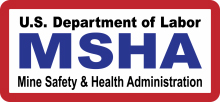Lowering the mine fatality rate
The Mine Safety & Health Administration (MSHA) announced that the 2016 fiscal year ending Sept. 30 had the lowest fatality incidence ever recorded for the more than 13,000 operating U.S. metal/nonmetal and coal mines.
This historic low includes nearly seven months with only three fatalities at metal/nonmetal mines. That is extraordinary. Can the accomplishment be improved?
MSHA relies on enforcement to drive down fatalities but may have more success with education and outreach aimed at helping management be more informed on causes and prevention. MSHA reports all accidents and seeks to identify root causes and best practices for prevention. MSHA also publishes near-miss alerts.
Fatalities in fiscal-year 2016
 Here are some of the fatal accidents that occurred at surface metal/nonmetal mines in 2016. Most involve issues with mobile equipment safety.
Here are some of the fatal accidents that occurred at surface metal/nonmetal mines in 2016. Most involve issues with mobile equipment safety.
■ At a sand operation, a haul truck driver backed over a dump site and died after the truck fell 60 ft.
■ At a stone quarry, a haul truck operator positioning to dump over a highwall died when the truck rolled over the edge and fell 90 ft.
■ At a granite mine, a long-experienced haul truck driver was fatally injured when his truck went over a berm and fell 150 ft. from a highwall edge.
■ A dozer operator working on a haul road leading to a pit was fatally injured when he either fell or stepped on the left side dozer track as the machine moved backward down a slope.
■ A haul truck operator and an excavator operator were fatally engulfed when an adjacent waste material embankment failed.
■ An excavator operator loading shot rock into haul trucks at a limestone quarry was killed by material falling from a highwall onto his equipment cab.
■ During the forklift unloading of large polyurethane pipes (each 50 ft. long and weighing 1,750 pounds) from a tractor-trailer, a single section of pipe unexpectedly rolled off while the forklift was away. The truck driver on foot was struck and killed.
■ At a cement plant barge load-out, temporary chute rigging gave way while an employee tried to tighten lift cables, causing him to be fatally pinned to the chute.
■ At a processing plant, an employee fell 50 ft. to his death through an opening near an elevated walkway.
■ A mechanic hit his head when he fell from the ladder of a front-end loader and lost consciousness for several minutes. Upon regaining consciousness, he was sent by ambulance to a hospital, but his condition worsened and he died.
MSHA-recommended best practices
Here are some of the best practices MSHA recommended following these accidents.
■ Thoroughly examine work areas.
■ Establish and discuss safe procedures before beginning work.
■ Avoid positioning yourself in places where you could be hurt if something goes wrong.
■ Look, listen and evaluate ground conditions daily and whenever there are weather events.
■ Make sure embankments with waste and moisture are constructed for stability.
■ Keep mining a safe distance away from waste embankments.
■ Always wear your seat belt in mobile equipment.
■ Set parking brakes and drop
blades and buckets before dismounting equipment.
■ Dump material behind previously deposited material and use other equipment to push over.
■ Always maintain a temporary safety berm with the newest dumped material deposited.
Planning for prevention
Will there be fewer fatalities in 2017, or more? Accident prevention is not an accident. There can never be too much encouragement, supervision and example to instill cautionary habits. Luck will save lives, but luck is not a safety program.
Workers are not safe unless everyone in the workforce develops a habit of being cautious. There can be no higher management goal. Cautiousness will save lives.
Michael Heenan and Margo Lopez are with the national labor, employment and safety law firm Ogletree Deakins. Contact them at michael.heenan@odnss.com and margaret.lopez@ogletreedeakins.com.









